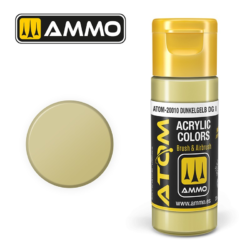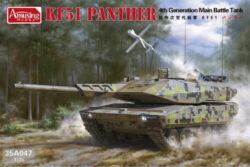Takom 2176 – Sd.Kfz.171 Sd.Kfz.267 Panther A Late 2in1
42,50€
– Plastic model kit to build a Sd.kfz.267 Panther Ausf. A Late Production 1/35 Takom.
– Scale plastic kit include photo-etch, clear parts and decals.
– Model to be assembled and painted. Glue and paint not supplied.
1 en stock
The Takom 2176 is a 1/35 scale model kit featuring the Panther A Late Sd.Kfz.171/268 German tank. This kit stands out for offering a “2 in 1” version, allowing modelers to build either the late variant of the Panther A or the Sd.Kfz.171/268 variant.
Key Features:
- Multiple Build Options: The kit includes parts to build two distinct Panther configurations, providing flexibility for customization.
- Photo-Etched Parts: Fine photo-etched components are included for precise detailing, such as engine grilles and external fittings.
- Rotating Turret and Movable Gun Barrel: Provides realism with a movable turret and gun barrel, allowing for dynamic display poses.
- Workable Tracks: Fully functional link-and-length tracks, accurately designed to mimic the Panther’s unique tread system.
- Detailed Suspension System: Includes intricate suspension and wheel components for an accurate build.
This kit is suited for advanced modelers looking for both versatility and detail, especially those interested in German WWII vehicles
Sd.Kfz. 267 Panther Ausf. A
The Sd.Kfz.267 Panther Ausf. A was a specialized command variant of the Panther Ausf. A tank, designed for battlefield coordination and communication within German armored divisions during World War II. Known as the “Panzerbefehlswagen Panther,” this variant retained the essential characteristics of the standard Panther Ausf. A while incorporating extensive communication equipment to support command operations. Entering production in 1943, the Sd.Kfz. 267 played a vital role in managing the complex armored engagements typical of the Eastern and Western Fronts.
Design and Armament
The Sd.Kfz. 267 was powered by the same Maybach HL230 P30 engine as the standard Panther, delivering 700 horsepower and allowing the tank to reach speeds of up to 46 km/h on roads. This speed enabled it to keep pace with other frontline units, a crucial feature for a command vehicle that needed to move alongside active armored elements to effectively direct operations. Although it was configured as a command tank, the Sd.Kfz. 267 maintained the 7.5 cm KwK 42 L/70 cannon, providing it with formidable anti-armor capability and ensuring it could defend itself if engaged by enemy forces.
Communication and Specialized Equipment
The primary feature distinguishing the Sd.Kfz. 267 from other Panther tanks was its enhanced communication setup. This command variant was fitted with the FuG 5 radio, standard to most tanks for basic communications, and the FuG 8 long-range radio system, which allowed communication with divisional headquarters and other distant units. The FuG 8 setup required a large star antenna mounted on the rear deck, easily identifying the Sd.Kfz. 267 as a command vehicle. This setup allowed the tank to coordinate battalion and company-level movements, relaying commands and status reports between units effectively.
Inside the tank, the crew had additional communication equipment and dedicated space for command personnel, such as a radio operator and a staff officer. This layout, however, reduced ammunition storage and required slight interior modifications to accommodate the radio systems and associated electronics, slightly impacting its operational duration in prolonged engagements.
Operational Role and Effectiveness
The Sd.Kfz. 267 Panther Ausf. A was deployed in armored units as a command and control vehicle, crucial for synchronizing unit movements and implementing strategic directives in the heat of battle. Its combination of protection, mobility, and advanced communication made it highly effective for battlefield command, especially on fast-moving fronts where real-time coordination was essential. Although it faced challenges from frequent mechanical issues, the Sd.Kfz. 267’s ability to manage complex maneuvers and adapt to battlefield dynamics enhanced the effectiveness of German armored divisions.
Legacy and Impact
The Sd.Kfz. 267 Panther Ausf. A exemplified the integration of armored firepower with advanced communications, emphasizing the need for dedicated command vehicles in mechanized warfare. The concept of a command tank, combining combat and coordination roles, influenced later command vehicle designs, setting a precedent for postwar command-and-control systems in modern armored units.

















